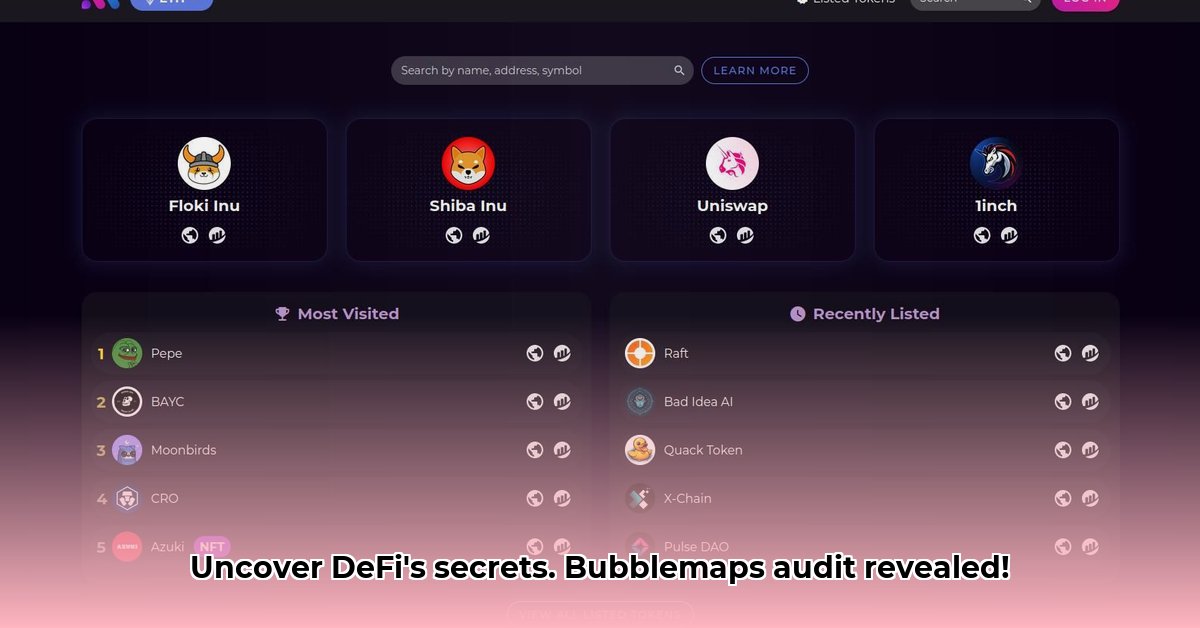
Bubblemaps is a novel DeFi (decentralized finance) auditing tool employing a visual representation using bubble charts to display on-chain data, potentially improving user comprehension of complex transactions and smart contract interactions. This review provides a detailed analysis of its functionality, strengths, weaknesses, and risks, guiding both technical and non-technical users.
Understanding Bubblemaps' Visual Approach to DeFi Auditing
Traditional DeFi auditing often involves navigating complex spreadsheets and code. Bubblemaps offers a refreshing alternative: a visual representation of on-chain data using interactive bubble charts. Larger bubbles represent larger transactions or key actors, while colors and proximity illustrate relationships and patterns. This intuitive approach allows for a quicker grasp of complex interactions, potentially revealing bottlenecks, unusual activities, or red flags without deep technical expertise. Is this revolutionary simplification truly effective, however? Let's examine the evidence.
Bubblemaps Crypto: Strengths and Limitations
While Bubblemaps' visual appeal is undeniably attractive, a balanced assessment requires acknowledging both its strengths and weaknesses.
Advantages:
- Intuitive Interface: The user-friendly interface significantly lowers the barrier to entry, making complex DeFi data accessible to a broader audience, including non-technical users. This accessibility is a major selling point in a field often dominated by technical jargon.
- Unique Visual Representation: The innovative use of bubble charts offers a unique selling proposition, differentiating Bubblemaps from competitors relying on more traditional data presentation methods. This visual approach allows for faster identification of anomalies and patterns.
- Rapid Insight Generation: The visual nature facilitates quicker identification of potential issues or anomalies within DeFi protocols, potentially offering a crucial time advantage in risk mitigation.
Disadvantages:
- Limited Browser Compatibility: Currently, the optimal user experience is limited to Google Chrome. This constraint significantly restricts accessibility and broad adoption. Improved cross-browser compatibility is critical for widespread use.
- Scalability Concerns: While effective with smaller datasets, scalability remains a concern. The ability to efficiently handle the massive datasets characteristic of large DeFi protocols needs further testing and improvement.
- Competitive Landscape: The DeFi security and analysis market is competitive. Bubblemaps must continually innovate and improve to maintain its position among established players offering a wider range of features and functionalities.
Using Bubblemaps: A Practical Guide
Utilizing Bubblemaps is relatively straightforward, although current limitations in browser compatibility and documentation may impact initial ease of use. Follow these steps:
- Access the Application: Launch the Bubblemaps application in your web browser (currently, Google Chrome is recommended for optimal performance).
- Data Selection: Choose the specific DeFi protocol or token for analysis. The application typically provides search functionality or a dropdown menu for selection.
- Interactive Exploration: The generated bubble chart allows for interactive exploration. Utilize features like tooltips and zoom functionality to gain detailed insights into data relationships.
- Interpreting Results: Carefully analyze the bubble chart to identify potential risks, patterns, or areas needing further investigation. Pay close attention to bubble sizes, colors, and their relative positions.
Navigating Risks and Regulatory Considerations
Bubblemaps' future success depends on addressing several key challenges. Expanding browser compatibility beyond Google Chrome is paramount for broader adoption. Enhanced scalability is crucial to handle the growing complexity and size of DeFi protocols. Improved documentation and tutorials will significantly improve user experience and adoption rates.
Furthermore, navigating the regulatory landscape is vital. Compliance with KYC (Know Your Customer), AML (Anti-Money Laundering), GDPR (General Data Protection Regulation), and other relevant regulations is non-negotiable for long-term sustainability. Proactive measures and legal counsel are essential for compliance and risk mitigation.
Risk Assessment Matrix
The following matrix outlines potential risks and mitigation strategies:
| Risk Factor | Likelihood | Impact | Mitigation Strategy |
|---|---|---|---|
| Limited Browser Compatibility | High | High | Prioritize cross-browser support; rigorous testing on all major browsers. |
| Scalability Issues | Medium | High | Invest in robust, scalable infrastructure; optimize data processing algorithms. |
| Intense Market Competition | High | Medium | Focus on niche markets; continuously improve the visual interface and features; strategic partnerships. |
| Inaccurate Data Presentation | Low | Very High | Implement rigorous data validation and verification procedures; transparent data sourcing. |
| Regulatory Changes and Compliance | Medium | High | Establish strong legal compliance procedures; continuous monitoring and adaptation to changing regulatory environments. |
Conclusion: Bubblemaps' Potential and Future Outlook
Bubblemaps' innovative visual approach offers a significant advantage in DeFi auditing but requires addressing several key limitations to reach its full potential. Expanding browser compatibility, improving scalability, enhancing documentation, and ensuring regulatory compliance are critical for sustained growth and success. The platform's future depends on overcoming these challenges and capitalizing on its unique visual appeal and intuitive design.